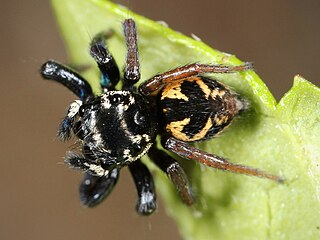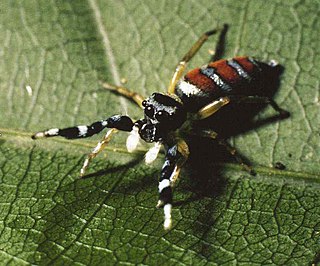
Anasaitis is a genus of jumping spiders that was first described by E. B. Bryant in 1950. The name is derived from the salticid genus Saitis.

Beata is a genus of jumping spiders that was first described by George Peckham & Elizabeth Peckham in 1895.

Breda is a genus of jumping spiders that was first described by George Peckham & Elizabeth Peckham in 1894.
Chirothecia is a genus of jumping spiders that was first described by Władysław Taczanowski in 1878. Chirothecia is very similar to Bellota, but can be distinguished by the following characteristics: a much wider and taller cephalothorax ; a much longer eye area ; the posterior median eyes are always closer to the anterior lateral eyes than the posterior lateral eyes.

Compsodecta is a genus of Caribbean jumping spiders that was first described by Eugène Louis Simon in 1903.

Corythalia is a genus of jumping spiders that was first described by Carl Ludwig Koch in 1850.

Cotinusa is a genus of jumping spiders that was first described by Eugène Louis Simon in 1900.
Descanso is a genus of jumping spiders that was first described by George and Elizabeth Peckham in 1892. The name is derived from Spanish descanso, meaning "resting place ", from the verb descansar "to rest."

Freya is a genus of jumping spiders that was first described by Carl Ludwig Koch in 1850. The name is derived from Freya, the fertility goddess of Norse mythology.

Lyssomanes is a spider genus of the family Salticidae, ranging from South and Central America, up to the southern United States.

Pachomius is a genus of jumping spiders that was first described by George and Elizabeth Peckham in 1896. Uspachia was merged into genus Romitia in 2007, and all nine species were merged into Pachomius in 2015. The name is derived from Pachomius, the founder of cenobitic monasticism.

Peckhamia is a genus of jumping spiders that was first described by Eugène Louis Simon in 1900. It is named in honor of George and Elizabeth Peckham, and is considered a senior synonym of the genus Consingis.

Phiale is a genus of jumping spiders that was first described by Carl Ludwig Koch in 1846. P. albovittata has been considered a junior synonym of Freya perelegans since 2006.

Psecas is a genus of jumping spiders that was first described by Carl Ludwig Koch in 1850.

Sarinda is a genus of ant mimicking jumping spiders that was first described by George and Elizabeth Peckham in 1892.

Synemosyna is a genus of ant mimicking jumping spiders that was first described by Nicholas Marcellus Hentz in 1846.

Zygoballus is a genus of jumping spiders found in North and South America.

Euophryini is a tribe of jumping spiders. It has also been treated as the subfamily Euophryinae.

Colonus is a genus of spiders in the jumping spider family, Salticidae. Colonus species are endemic to North and South America, ranging from New York to Argentina. All members of the genus have two pairs of bulbous spines on the ventral side of the first tibiae. The function of these spines is unknown. Colonus was declared a junior synonym of Thiodina by Eugène Simon in 1903, but this was reversed by Bustamante, Maddison, and Ruiz in 2015.

















